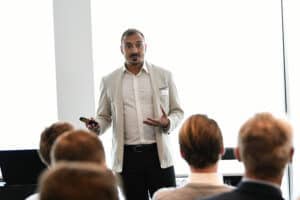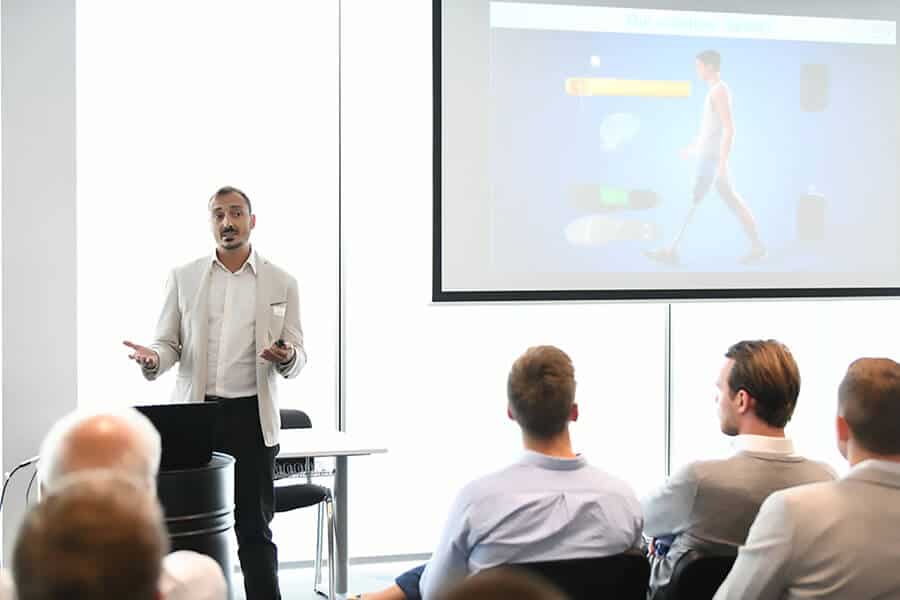The idea of connecting the brain and the nerves with machines has always been captivating for Dr.Francesco Petrini. In 2013 he participated in a groundbreaking international project where a team of numerous eminent experts from different scientific fields managed to implant the neural electrodes into a human in a way an amputee could feel sensations. This revelation inspired Dr.Petrini to work hard, explore and make the most out of his passion for bio-engineering and helping people. The result? An award-winning prosthesis SENSY, which allows amputees to naturally feel their missing limbs.
In 2013, an electrode was implanted into Dennis, one of many amputees, representing the first European case of neural electrodes implanted in humans. First time after losing his hand, Dennis felt lifelike sensations from his fingers. This was an enormous success of a research project done by an international team of robotics experts, engineers, surgeons and neuroscientists, from Italy, Switzerland and Germany. Dr. Francesco Petrini was among this groundbreaking group.
As a kid, Petrini would spend hours watching science fiction movies and Superheroes as well as opening devices to see how they work, hoping one day he will make miracles happen. And he did. He has turned fantasy into reality by dedicating last seven years of his work to develop hi-tech solutions that will help people with lost extremities.
His greatest wish is for these achievements to be used for medical reasons, not for augmenting the abilities of a human body. Only this way, technology will serve it’s key purpose – being accessible to everyone, regardless of their status.
Dr.Francesco, thank you for taking the time to share your story with us. What are you working on at the moment and what makes you feel stress-free in these challenging times we are all going through?
I am full-time CEO of SensArs Neuroprosthetics, which I co-founded in 2014 with two friends and research colleagues. I am co-ordinating the development of our first industrial prototype for clinical experimentations planned by 2022. Our aim is to give our products to amputees who suffer phantom limb pain, incurable with presently available medications.
Other than being an entrepreneur, I am an inventor: I enjoy discussing research projects with ex-colleagues, and giving my contribution. In the rest of my free time, I enjoy the company of family and friends (at least the ones I am allowed to see, in this particular historical period), do lots of sport, and read (I like politics, human behavioral studies and novels). I also like to cook new food recipes.
My motto: get busy, smile in the morning and you won’t be stressed.
You hold a PhD in neural engineering (University Campus Bio-Medico, Rome). When did you first become interested in a science of this kind, were you a kid with specific hobbies and interests?

I have always enjoyed engineering, mathematics, physics: taking devices, opening them, and understanding how they were designed has always caught my interest. At the end of high school, when I had to choose my university career, I combined this passion with the one of helping people. Thus, bio-medical engineering was an obvious choice.
At the end of these studies, I developed a passion for the nervous system. The idea of connecting the brain, the nerves with machines fascinated me. To exchange info from the human to the machine and vice-versa stimulated all the fantasies I developed when, as a kid, I was watching super-hero or science fiction movies. I got in contact with a research group working on this, in the city where I was studying, Rome and I started the adventure.
What motivated you to found your company, SensArs Neuroprosthetics?
In 2010, top-notch European research institutions (i.e. the Scuola Superiore Sant’Anna of Pisa, Gemelli and Campus Bio-Medico of Rome, EPFL of Lausanne, IMTEK of Freiburg, INRIA of Montpellier, Universidad Autonoma de Barcelona, University of Aalborg) allied to build and test a device that could restore sensory feedback to amputees. I joined the team in 2011, first as a research fellow, then as a PhD student.
We developed the first neural electrode transversally implantable into peripheral human nerves. In 2013, this electrode was implanted in one amputee patient, Dennis, representing the first European case of neural electrodes implanted in humans. The stimulation of his arm nerves through these electrodes was modulated according to signals coming from pressure sensors embedded in a prosthetic hand.
We had built a device that was able to elicit natural sensations of touch from the fingers of the prosthetic hand.
The excitation appeared on the face of Dennis when he first used the device: “Guys, wow, I am feeling my hand. I bet I can recognize objects of different compliances”. Indeed, he did! He also managed to control the force intensity exerted with the prosthesis and to recognize objects of different shapes.
We also implemented a phantom pain treatment function: when Dennis felt attacks of pain, he could receive 10-30 minutes of non-dependent stimulation on external sensors. After a month of use, his pain had decreased by more than 50%.
“If you put this on the market, I will definitely get one,” he said.
The feedback of Dennis, together with the great media coverage we got pushed, me and my colleagues at EPFL of Lausanne, Stanisa Raspopovic and Silvestro Micera, to co-found SensArs Neuroprosthetics.
Since then, my mission has been to bring this technology to the market to allow people like Dennis to use it.
During the first steps of SensArs you were in charge of the business segment – fundraising, business plan preparation etc. What was the most challenging part of launching a biotechnological start-up?
I am an engineer who started to be a researcher after university study. What I learnt is that researchers identify problems and solve them. They do not focus on how big the population that is affected by those problems is, nor on who will pay for their solutions (which are the main questions to which businesses give a reply). This is a good thing: imagine a world in which no one dedicates time to rare diseases!
Because of this, the biggest challenge I had to face was to shift my mindset from research to business. The support (financing, coaching, acceleration programs) that Switzerland and EU are now offering to researchers trying to get off of the laboratory and start a company, has been of great help to me to achieve this.
From that moment on, the real challenge would have been to convince other people: a company that has to manufacture subsystems of my products, a talented engineer or business developer to join my team, a surgeon to do a clinical investigation with my product, an investor or an institution to give financing.
Well, a list of challenges, but it all goes down to one thing: be strong about your idea, your vision, and convince other people that they should follow it.
Your invention, prosthesis SENSY, which allows amputees to naturally feel their missing limbs, made you one of the winners of Innovators Under 35 Europe by MIT Technology Review. You worked on this important project with your closest team member and colleague, Dr.Stanisa Raspopovic who has dedicated a decade of his work to solve this problem. He works on neural interfaces and both of you managed to achieve a mini miracle – to develop a device that can tie nerves into machines. Tell us more on how you managed to do this?
We were part of a much bigger eco-system. Many institutions and great people collaborated by dedicating their brilliant minds to this cause. In 2010, Stanisa, a young researcher at that time, together with Prof. Thomas Stieglitz from IMTEK, Silvestro Micera from EPFL and Scuola Sant’Anna, Paolo Maria Rossini from Gemelli Hospital, David Guiraud from INRIA, Navarro from UAB, initiated the development of a new electrode to implant into the human nerves. In 2011 I had the chance of joining this extraordinary group of people. I didn’t let this train go.
This novel electrode, which in its final version for human uses, had the size and shape of a hair, could be implanted transversally through the nerve. The rational behind this development was to get in contact with the highest number of fibers inside the nerve by exploiting the minimum number of implants. Imagine the nerve as an electric cable, where every wire transports a piece of information. To get in touch with all the inner wires you will need an electrode inserted inside the nerve. By inserting longitudinal electrodes, you will need as many of them as the fibers that are inside the nerve. If instead, you insert transversally one electrode with many channels, you have optimized the solution.
After three years of brainstorming and micro-engineering productions, the electrode was ready to be tested on animals, and then on humans.
At this point, we needed to integrate the other pieces of technologies and write the software to control them. Recording systems, nerve stimulators, hand prosthesis. They all needed software that controlled them to transduce the language of the nervous system in machine language. After months in front of the computer, these devices were setup to communicate with the nervous system of the patient. The software was ready.
The electrode implanted into the nerve of the patient was the mean through which the signals would have moved between the body and the machine.
It was the end of 2013, we were starting the first tests with Dennis.
The rest is history.
What are the parts of this device and what makes it different than other products of this kind?
SENSY is constituted by wearable sensors that are added to any commercial prosthetic device, that drive the stimulation of the nerves of the extremities (the tibial nerve for the leg, the median and ulnar nerve for the arm). The stimulation is done by a stimulator and novel electrodes, which are implanted in the nerve through surgery procedure at the level of the thigh or the arm, respectively for leg and hand amputees. The first prototype of SENSY was tested on a hand amputee in 2013. SENSY was then tested on three other hand amputees to prove the functionality and safety of the technology for six months, as well as on three leg amputees, preliminarily proving that sensory feedback diminishes pain, falls, and fatigue, and increases confidence and mobility.
Currently, there are no commercial solutions for restoring sensory feedback to amputees through their prosthesis and current prostheses are quite limited in health benefits. Prosthetic companies (e.g. Össur and Ottobock) do not sell or produce prosthetic devices or any technology that can provide sensory feedback to the users. Companies in the neuroprosthetic market do not sell or produce devices to restore sensory feedback to the amputees from their prosthesis. There are two companies (Cyberonics and Neuros Medical) that implant the peripheral nerves with cuff electrodes, which are not efficient for sensory feedback restoration: cuff electrodes are implanted around the nerve (not inside it, as in SENSY) and elicit non-natural sensations from larger areas of the phantom extremity (e.g. user senses stimulation in fingers and palm at the same time). As such, it impedes user acceptance and thus reduces benefits for the prosthesis use, or pain treatment.
SENSY also improves mobility and agility of users – they can climb stairs or walk on uneven ground. What about navigating tricky terrains, will hiking or running be possible?
We have demonstrated that amputees, when equipped with natural sensations coming from their commercial prosthesis, improve the ability of controlling such devices. They have more confidence and are more able to predict dangerous events (e.g. falls). This will allow them to better move on terrains whose features they do not know or in the dark.
At SensArs, we do not work on the development of the mechanical part of the prosthesis. But as far as the prosthesis allows the person with amputation to execute specific movements such as running, hiking, climbing stairs, walking SENSY will facilitate their execution.
Where are you at, when it comes to testing and wider implementation?
We are now developing our final industrial prototype, with the support of the European commission through the Horizon 2020 GoSafe. This prototype will be fully implantable and able to communicate with wearable sensors placed outside the body, as well as with smartphones or tablets. With these smart technologies, the clinician will be able to calibrate SENSY for the use from the specific person, and to monitor its performance (pain reduction and prosthesis control). The patient will be able to control the start of the pain treatment stimulation program.
We plan to finish the prototype by 2021 and, after preclinical validation, to start the human experimentations for commercialisation clearance by 2022.
We aim at commercialisation by the end of 2023.
How do you see future of biotechnology, will cyborgs be a regular part of our everyday lives?
Moore’s law has been formulated for many sectors. Biotechnology is one of them. The curve of technology improvement doubles every two years.
Our future will have devices that will be entirely integrated with our body. Devices which are natural to control and to feel, as it is controlling my hand now while typing for this interview and receiving the feedback of pressing buttons. That can allow a paraplegic to control a computer with the brain or that can replace the damaged portion of the spinal cord.
I have one recommendation for the world leadership: discuss well the use of such technologies. Use them for medical reasons and not for augmenting the abilities of people (especially if they are already able bodied).
The risk of not doing that is to create a big gap between people with the economic capabilities of accessing these technologies and people without. In other words, the risk is to create another instrument to increase the distance between poor and rich people in the world.
This would realise the opposite of what I am working for, which is helping people and amputees.
Photos: Venturelab AG
Read another inspirational story here:
Charlotte Wessel Skovlund PhD: What You Should Know Before You Take The Pill
Support us!
All your donations will be used to pay the magazine’s journalists and to support the ongoing costs of maintaining the site.
Share this post
Interested in co-operating with us?
We are open to co-operation from writers and businesses alike. You can reach us on our email at [email protected]/[email protected] and we will get back to you as quick as we can.










